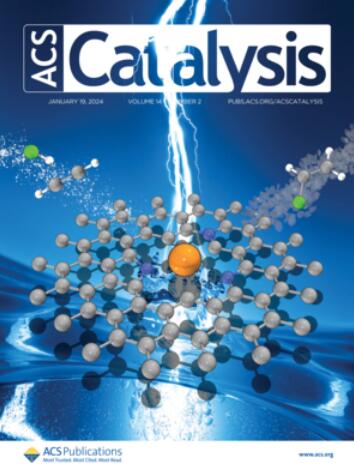电压驱动的Rh(III/IV/V)氧化态导航:揭示电化学C-H活化/环化的机制秘密和选择性
IF 13.1
1区 化学
Q1 CHEMISTRY, PHYSICAL
引用次数: 0
摘要
利用电子作为唯一的氧化还原试剂,电化学驱动的铑催化的C-H键环化代表了一种有前途的策略,可以实现有机合成中具有挑战性的转化。然而,电化学条件对反应机理的影响尚不清楚。通过对关键基本步骤──C-H活化、迁移插入、β-H消除和还原消除──的计算分析,我们描述了电化学条件下Rh(III)、Rh(IV)和Rh(V)氧化态的不同作用。我们的研究结果表明,C-H活化在Rh(III)最有利,而迁移插入可能发生在Rh(III)和Rh(IV)。β-H在Rh(IV)下易于消除,而还原消除只在Rh(V)下进行。此外,通过调节阈值为0.96 V的外加电位,可以很好地控制五元环和六元环产物之间的选择性。这些发现为过渡金属催化的电化学C-H活化/环化提供了有价值的机理见解,为未来的合成应用提供了指导。本文章由计算机程序翻译,如有差异,请以英文原文为准。
Voltage-Driven Navigation of Rh(III/IV/V) Oxidation States: Unraveling Mechanistic Secrets and Selectivity in Electrochemical C–H Activation/Annulation
Electrochemically driven rhodium-catalyzed C–H bond annulation represents a promising strategy for achieving challenging transformations in organic synthesis, utilizing electrons as the sole redox reagent. However, the influence of electrochemical conditions on the reaction mechanism remains underexplored. Through computational analysis of the critical elementary steps─C–H activation, migratory insertion, β-H elimination, and reductive elimination─we delineate the distinct roles of Rh(III), Rh(IV), and Rh(V) oxidation states under electrochemical conditions. Our findings demonstrate that C–H activation is most favorable at Rh(III), while migratory insertion could occur at both Rh(III) and Rh(IV). The β-H elimination is facilitated at Rh(IV), and reductive elimination proceeds exclusively at Rh(V). Furthermore, by modulating the applied potential with a threshold of 0.96 V, the selectivity between five- and six-membered ring products can be finely controlled. These findings provide valuable mechanistic insights into transition metal catalyzed electrochemical C–H activation/annulation, offering guidance for future synthetic applications.
求助全文
通过发布文献求助,成功后即可免费获取论文全文。
去求助
来源期刊

ACS Catalysis
CHEMISTRY, PHYSICAL-
CiteScore
20.80
自引率
6.20%
发文量
1253
审稿时长
1.5 months
期刊介绍:
ACS Catalysis is an esteemed journal that publishes original research in the fields of heterogeneous catalysis, molecular catalysis, and biocatalysis. It offers broad coverage across diverse areas such as life sciences, organometallics and synthesis, photochemistry and electrochemistry, drug discovery and synthesis, materials science, environmental protection, polymer discovery and synthesis, and energy and fuels.
The scope of the journal is to showcase innovative work in various aspects of catalysis. This includes new reactions and novel synthetic approaches utilizing known catalysts, the discovery or modification of new catalysts, elucidation of catalytic mechanisms through cutting-edge investigations, practical enhancements of existing processes, as well as conceptual advances in the field. Contributions to ACS Catalysis can encompass both experimental and theoretical research focused on catalytic molecules, macromolecules, and materials that exhibit catalytic turnover.
 求助内容:
求助内容: 应助结果提醒方式:
应助结果提醒方式:


